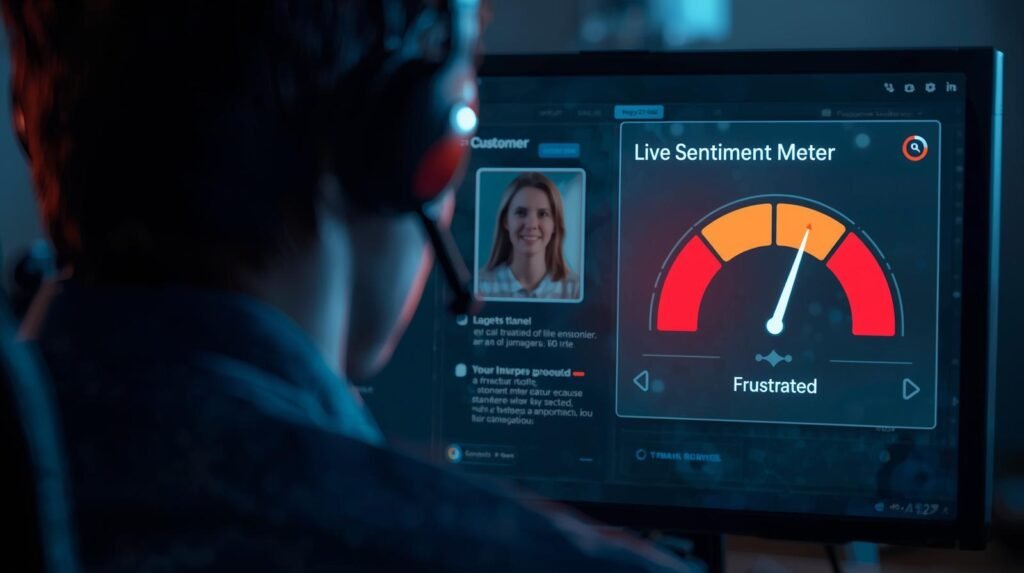Hey everyone! I’m Adnan from The Insurtech Guide. We’ve all been there: stuck on a customer service call, getting more and more frustrated as we talk to a robotic-sounding agent or a clueless chatbot. The experience often feels cold, impersonal, and lacking in basic human empathy.
As I’ve been tracking the future of InsurTech, I’ve come across a cutting-edge technology that aims to solve this very problem: Emotional AI. The idea is to create systems that can understand and react to human emotions.
This led me to wonder, what is the role of AI emotional analytics in insurance customer service? Could a machine ever truly be empathetic? I did a deep dive into this fascinating and slightly controversial trend to understand how it works and what it means for the future of our interactions with insurance companies.

Table of Contents
What is Emotional AI? (And How Does It Work?)
Emotional AI, also known as sentiment analysis, AI emotional analytics in insurance is a branch of artificial intelligence that can detect and interpret human emotions from various data sources.
From my research, I found it primarily works in three ways:
- Voice Emotion AI: This technology analyzes the tone, pitch, and tempo of your voice during a phone call to detect emotions like anger, frustration, or happiness.
- Facial Recognition: By analyzing micro-expressions through a camera (for video calls), it can read your emotional state.
- Natural Language Processing (NLP): This is the most common form. It analyzes the words and phrases you use in a chat or email to determine the sentiment behind your message.
The goal isn’t just to “spy” on you; it’s to give the customer service system—whether it’s a human agent or a chatbot—real-time feedback on how you’re feeling.

3 Ways Emotional Analytics Will Change the Customer Experience
This isn’t just a gimmick. AI emotional analytics in insurance has the potential to create a dramatically better customer journey. Here are the three biggest changes I foresee.
1. The Rise of Truly Empathetic AI Chatbots
The biggest complaint about chatbots is that they’re robotic. Emotional AI changes that.
- How it works: An AI chatbot powered by NLP can detect frustration in your typed messages. For example, if you type “This is the THIRD time I’m asking this!” the AI will recognize your anger.
- The Future Experience: Instead of giving another robotic answer, the empathetic AI chatbot could respond with, “I can see you’re frustrated, and I apologize. Let me connect you directly to a human specialist who can resolve this for you right away.” This ability to de-escalate a situation is a game-changer.
2. Super-Powered Human Agents
This technology isn’t just for bots; it’s for humans too.
- How it works: During a call, voice emotion AI can provide a human agent with a real-time “emotion dashboard.” It might flash a small alert on their screen that says, “Customer’s frustration is rising.”
- The Future Experience: This gives the agent a cue to change their approach. They can become more empathetic, offer a specific solution, or escalate the call to a supervisor before the customer reaches their breaking point. It turns a good agent into a great one.

3. Proactive Problem Solving
The ultimate goal is to solve problems before they even escalate.
- How it works: Insurers can use AI to analyze thousands of customer service calls and chats to find common points of frustration.
- The Future Experience: If the AI discovers that hundreds of people are getting angry when asked a specific question during the claims process, the company can proactively fix that step. They can use the analytics to improve their processes, creating a smoother experience for everyone.
The Ethical Questions
Of course, the idea of an AI “listening” to our emotions raises important ethical questions about privacy and manipulation. As a society, we will need to establish clear rules about how this data is used and ensure it’s for improving service, not for exploitation. Transparency will be key.
Final Verdict: A More Human Future?
The goal of AI emotional analytics in insurance is, ironically, to make the customer service experience feel more human. By understanding our emotional state, companies can respond with more empathy, solve our problems faster, and build a relationship based on trust, not frustration.
While the ethical lines must be drawn carefully, I believe this technology holds the key to fixing the cold, impersonal nature of customer service and creating a future where you feel truly heard and understood.





Leave a Reply